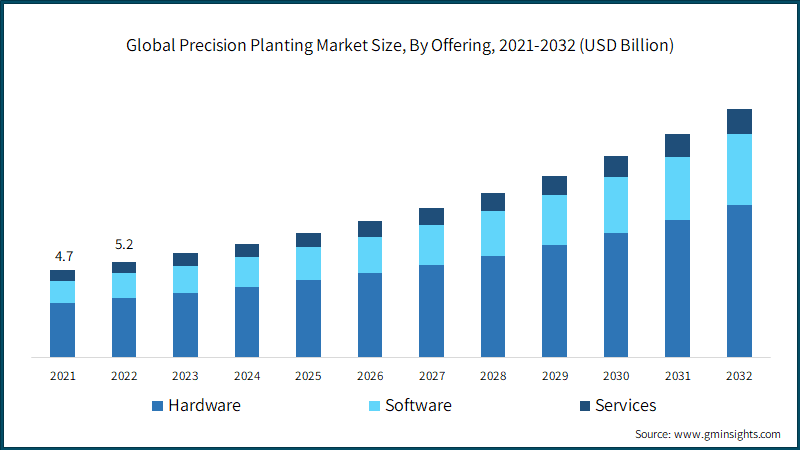Home > Agriculture > Agri Machinery & Tech > Agri Equipment > Precision Planting Market
Precision Planting Market Analysis
- Report ID: GMI7097
- Published Date: Oct 2023
- Report Format: PDF
Precision Planting Market Analysis
Based on offering, the market is segmented into hardware, software, and services. The hardware segment is further divided into automation & control and sensing & monitoring. The hardware segment dominated over 60% of the market share in 2022.
- Precision planting provides various planting equipment & components designed to improve planting accuracy and efficiency. This may include specialized planter units, seed meters, downforce control systems, and row cleaners. Some of these equipment also include equipment for precise fertilizer placement during planting to optimize nutrient distribution for optimal crop growth.
- Some of this equipment also include yield monitoring technology, allowing farmers to measure & record crop yields accurately. This feature allows farmers to assess the effectiveness of planting practices.

Based on drive type, the market is divided into electric drive and hydraulic drive. The electric drive segment is anticipated to register 10% CAGR throuh 2032.
- Electric drives enable variable rate planting, which means the seed population can be adjusted on the go. This is based on data & mapping, enabling farmers to plant more seeds in areas with high yield potential and fewer seeds in less productive areas. Electric drives provide precise control over planting depth, spacing, and speed. This consistency is essential for optimal seed placement, which can significantly impact crop yields.
- These systems often offer user-friendly interfaces and remote monitoring capabilities. Farmers can adjust & monitor the planter's performance from the cab of their tractor, enhancing efficiency and reducing operator fatigue. Many electric drive systems are integrated with data collection capabilities, which can provide valuable insights for future planting decisions and overall farm management.

North America dominated the global precision planting market with a share of over 35% in 2022. The region is growing due to the increasing demand for advanced agricultural technologies that enhance crop yields and reduce resource wastage. Farmers are adopting precision planting solutions to optimize seed placement, spacing, and depth, ultimately improving crop uniformity and overall productivity. Factors including climate variability and the need for sustainable farming practices are driving the adoption of precise planting techniques. Additionally, advancements in data analytics and the integration of precision agriculture tools are further fueling the growth of this market by providing farmers with actionable insights for informed decision-making.

